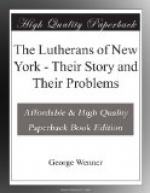But there was another class of immigrants that came to us from the Fatherland. They, too, sought to escape from political and economical conditions that had rested like an incubus upon a divided country for centuries. But they brought with them a spirit of Christian aspiration and the ripe fruit of a traditional Christian culture which became a priceless contribution to our own church life. They were men and women from all corners of Germany, who had come under the inspiration of the religious awakening to which reference has already been made. They became leading workers in our congregations and Christian enterprises. We, whose privilege it was to minister to them, knew well that we were only reaping where others far away and long ago had sown.
The inability of the Lutheran Church to supply an adequate ministry for this vast immigrant population left the way open also for other Protestant churches to do mission work among the lapsed members of our communion.
A number of churches were established where services in the beginning were held in the German or Scandinavian languages. Through Sunday Schools and other agencies many Lutheran children were gathered into their congregations where they and their children are now useful and honored members of the church. A goodly number of eminent ministers in various non-Lutheran Protestant churches of this city are the children or grandchildren of Lutheran parents.
[illustration: “Carl F. E. Stohlmann, D.D.”]
With this general outlook over the period, let us take up the thread of our story.
On the death of the elder Geissenhainer in 1838, Karl Stohlmann, a native of Schaumburg Lippe, was called from Erie, Pennsylvania, to be his successor. For thirty years the pastor of the Walker Street Church was an important figure among the Lutherans of this city. The scope of this book will not permit an adequate account of his labors. He died on Sunday morning, May 3d, 1868, just as his congregation was entering a larger house of worship at the corner of Broome and Elizabeth Streets.
Dr. Geissenhainer, Jr., retired from the English work of St. Matthew’s Church in 1840 and organized a German congregation, St. Paul’s, on the west side, which he served as pastor until his death in 1879 in the 82d year of his age.
On the East Side, Trinity was organized in 1843, St. Mark’s in 1847, St. Peter’s in 1862, Immanuel, in Yorkville, in 1863, and St. John’s in Harlem in 1864. On the West Side St. Luke’s was established in 1850, St. John’s in 1855 and St. Paul’s in Harlem in 1864. The first Swedish congregation, Gustavus Adolphus, was organized in 1865.
Within the present limits of Brooklyn six German and one English churches were established during this period. On the territory of each of the other boroughs, Bronx, Queens and Richmond, two German churches came into being.




